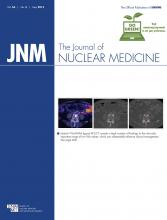Interim PET in DLBCL: Jamar and Lhommel provide a brief overview of the current status of interim 18F-FDG PET imaging of anti-CD20 immunotherapy in diffuse large B-cell lymphoma and highlight the potential for global collaborative studies.
Page 655
Radionuclides and gastrointestinal transit: Guidoccio and colleagues review the advantages of radionuclide investigation of motility across the entire gastrointestinal tract and preview a relevant article in this issue of JNM.
Page 657
Molecular imaging of infectious diseases: Glaudemans and colleagues look at the broad range of current imaging approaches in infection and inflammation and at the possibilities for expanding these efforts through molecular imaging agents and modalities.
Page 659
Genetics, glucose, and thyroid cancer: Nagarajah and colleagues use tumor uptake on 18F-FDG PET/CT to explore differences in glucose metabolism between patients with the BRAFV600E and BRAF wild-type mutations in metastatic differentiated or poorly differentiated thyroid cancer.
Page 662
PSMA-ligand PET/CT for restaging: Eiber and colleagues investigate the detection capabilities of PET/CT with a newly developed 68Ga-labeled prostate-specific membrane antigen ligand in patients with biochemical recurrence after radical prostatectomy.
Page 668
SLN detection in cervical cancer: Hoogendam and colleagues offer a systematic review and comparison of the performance of SPECT/CT and planar lymphoscintigraphy in overall and bilateral sentinel lymph node detection in patients with cervical cancer.
Page 675
PET/CT in hemodialysis: Tseng and colleagues explore the utility of 18F-FDG PET/CT in detection of infections of unknown origin in patients with end-stage renal disease undergoing maintenance hemodialysis.
Page 681
Combining 18F-NaF and 18F-FDG: Minamimoto and colleagues compare the biodistribution of 18F−/18F-FDG administration with that of separate 18F-NaF and 18F-FDG for imaging in patients with cancer and assess factors such as dosage and optimal timing.
Page 688
CT dose in PET/CT: Inoue and colleagues introduce and validate a practical method for estimation of the effective dose of the CT component of whole-body PET/CT using the scanner-derived dose–length product.
Page 695
PET TSPO density measurement: Lyoo and colleagues describe a simple ratio method as an alternative to absolute quantitation with arterial sampling in PET imaging of the 18-kDa translocator protein in investigations of Alzheimer disease.
Page 701
TSPO genotypes in AD: Fan and colleagues investigate whether different translocator protein genotypes influence cognitive function, amyloid load, and disease progression in Alzheimer disease and whether targeted small-group results using second-generation TSPO tracers can be extrapolated to larger populations.
Page 707
18F-FE-PE2I binding to dopamine transporter: Fazio and colleagues examine the suitability of this radioligand, developed for in vivo quantification of the dopamine transporter in the striatum and substantia nigra, for PET imaging of the nigrostriatal pathway in Parkinson disease.
Page 714
Comprehensive gastrointestinal transit study: Antoniou and colleagues describe and validate a 111In-DTPA/99mTc-labeled solid meal methodology and reference values for a single gastrointestinal transit study including esophageal transit, liquid and solid gastric emptying, and small- and large-bowel transit.
Page 721
Pediatric 99mTc-sestamibi MPI: Azarbar and colleagues present the results of a phase I–II, open-label, nonrandomized, multicenter trial of dosimetry and safety of 99mTc-sestamibi for myocardial perfusion imaging in children.
Page 728
Parathyroid imaging: Hindié and colleagues offer an educational overview of the importance of imaging in surgery for primary hyperparathyroidism, strategies for guiding limited surgery, and the potential of novel PET tracers in this setting.
Page 737
Claudin-4 SPECT in breast cancer: Mosley and colleagues describe whole-body quantitative SPECT imaging of preneoplastic breast cancer tissue in a mouse model using a 111In-labeled natural ligand for claudin-4, which is overexpressed in several premalignant lesions.
Page 745
GRP-R radioligands in breast cancer: Dalm and colleagues explore the application of gastrin-releasing peptide receptor radioligands for imaging and therapy of breast cancer with in vitro studies and animal models.
Page 752
PET of c-Met with recombinant HGF: Luo and colleagues report on the characterization of 64C-labeled recombinant human hepatocyte growth factor as a PET tracer for in vivo detection of c-Met protein expression.
Page 758
CMICE-013 MPI: Wells and colleagues assess the image quality of this novel 123I-labeled rotenone derivative, developed for SPECT myocardial perfusion imaging, and compare its uptake with that of tetrofosmin, sestamibi, and 201Tl in a porcine model of stress-induced myocardial ischemia.
Page 764
Scintillator balloon–enabled imaging: Zaman and colleagues detail the development of and validate a scintillator balloon–enabled fiber-optic radionuclide imaging system to improve the sensitivity and resolution of plaque imaging using 18F-FDG.
Page 771
Fibroblast radioimmunoimaging in RA: Laverman and colleagues explore the potential of SPECT/CT imaging with an anti–fibroblast activation protein antibody to visualize inflammation in mice with collagen-induced arthritis.
Page 778
Bi-PEGylated peptide for αvβ6: Hausner and colleagues evaluate the effect of site-specific C-terminal or dual N- and C-terminal PEGylation in peptides labeled with 18F-fluorobenzoic acid on αvβ6-targeted tumor uptake and pharmacokinetics.
Page 784
76Br-α-Me-Phe for PET: Hanaoka and colleagues describe the design, preclinical validation, and clinical potential of two 76Br-labeled amino acid derivatives as tumor imaging agents.
Page 791
99mTc-NTP 15-5 arthritis imaging: Khairnar and colleagues investigate the ability of this novel radiotracer, which targets proteoglycans, to accurately image rheumatoid arthritis and monitor cartilage remodeling in chronic nonsteroidal antiinflammatory treatment.
Page 798
CLI for radiation dose calculation: Lohrmann and colleagues assess whether Cerenkov luminescence imaging can be used to determine radiation doses of a 90Y-labeled gastrin-releasing peptide receptor antagonist in mice bearing prostate cancer xenografts.
Page 805
- © 2015 by the Society of Nuclear Medicine and Molecular Imaging, Inc.







